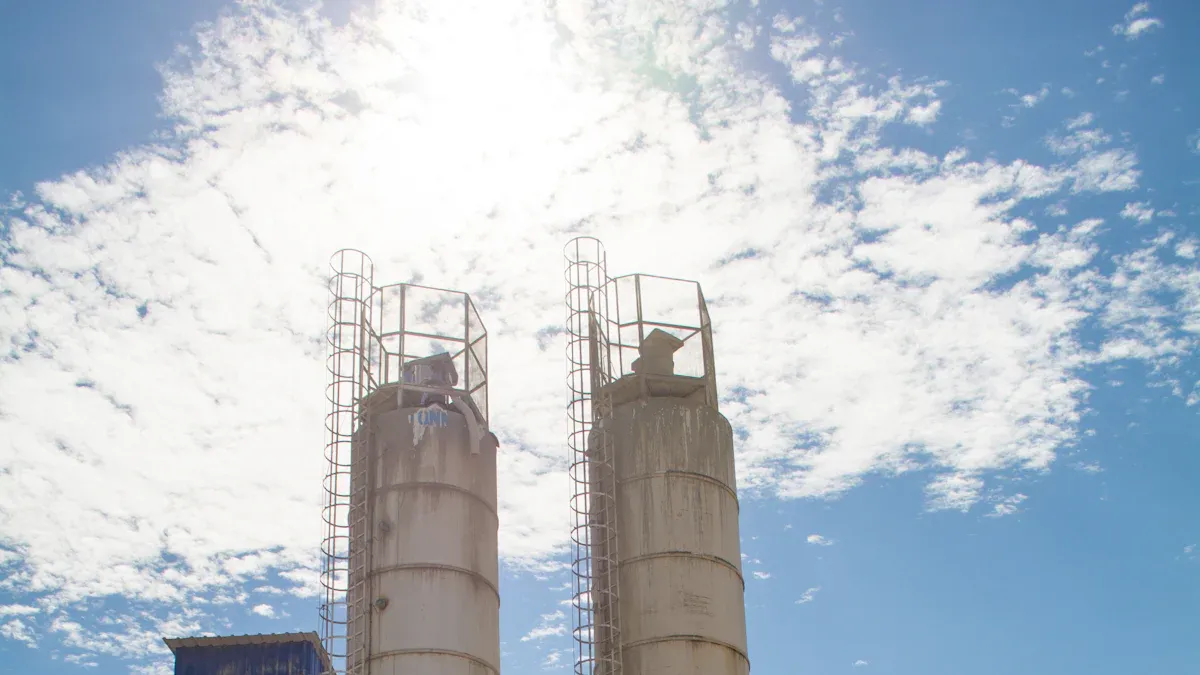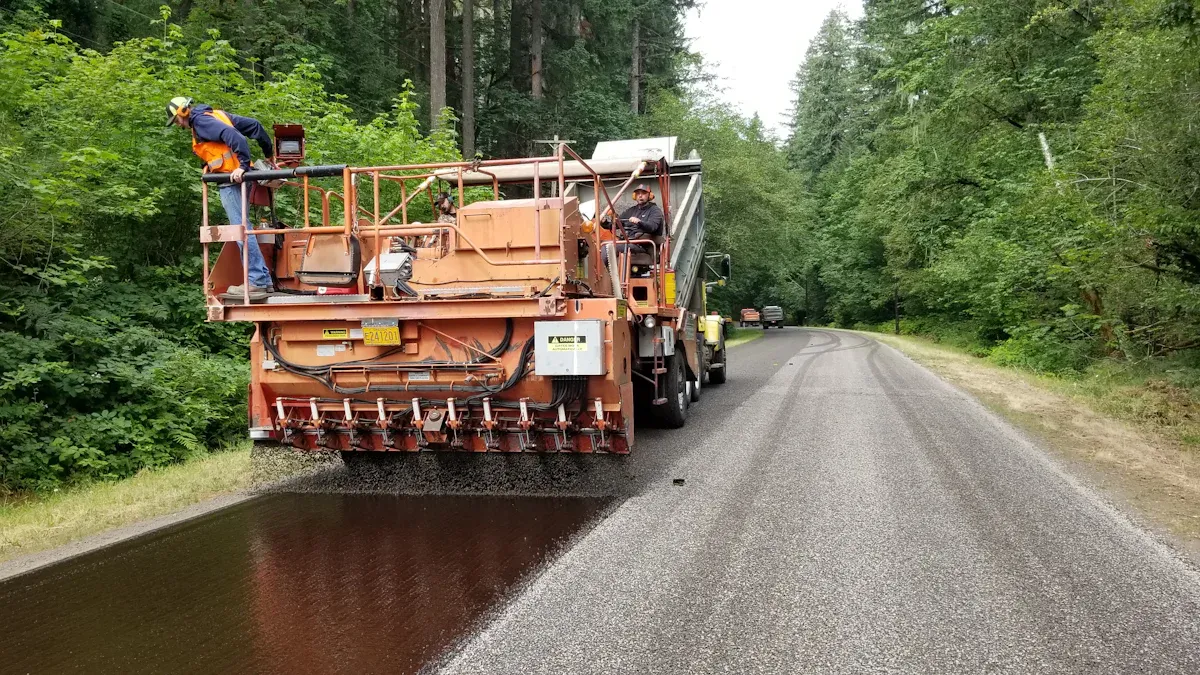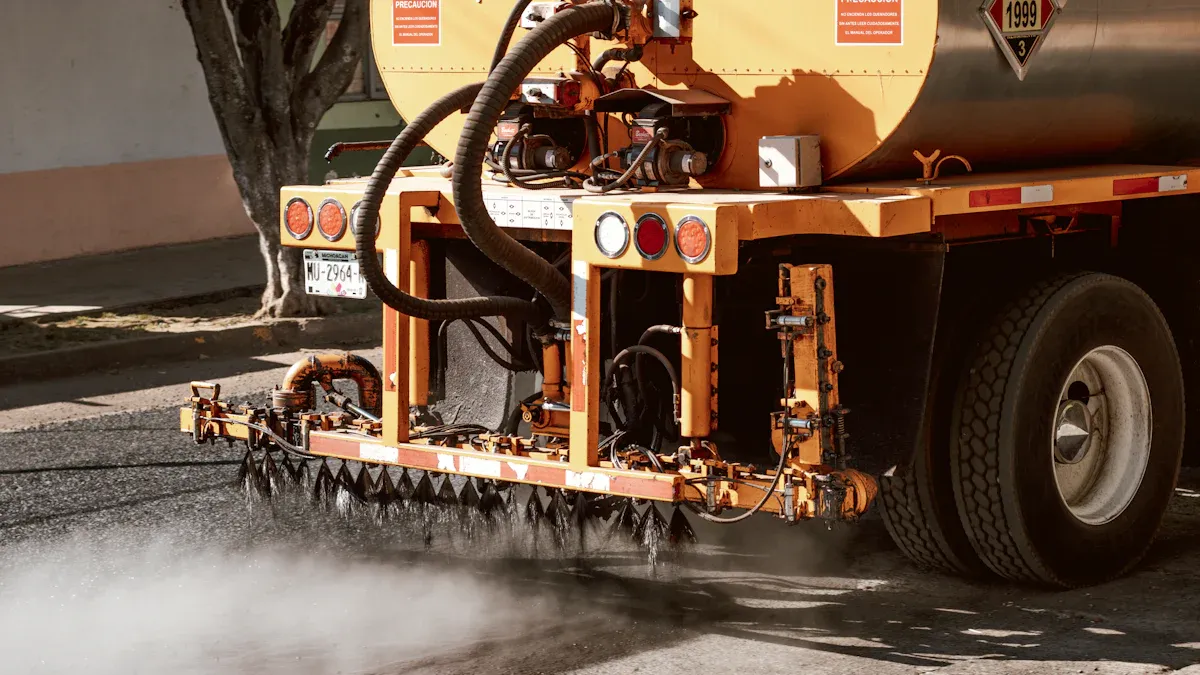
Wear parts are the backbone of your asphalt mixing plant's efficiency. These components endure constant friction, heat, and pressure during operation. When they wear out, the plant's performance drops, leading to delays and higher operating costs. Regular inspections help you spot worn parts before they fail. Replacing them on time ensures smooth operation and extends the lifespan of your equipment. By prioritizing maintenance, you minimize downtime and keep your asphalt mixing plant running at peak efficiency.

Mixing blades and paddles are essential components of an asphalt mixing plant. These parts ensure that materials like aggregates, bitumen, and fillers mix evenly to create high-quality asphalt. The blades and paddles rotate within the mixing chamber, breaking down clumps and distributing materials uniformly. Without them, the asphalt mixture would lack consistency, leading to poor performance in construction projects.
You rely on these parts to maintain the efficiency of your asphalt mixing plant. Properly functioning blades and paddles re duce mixing time and improve the overall quality of the output. Their role directly impacts the productivity of your plant and the durability of the asphalt produced.
Over time, mixing blades and paddles experience wear due to constant friction and contact with abrasive materials. You may notice reduced mixing efficiency or uneven asphalt consistency. V isible signs of wear include thinning edges, cracks, or deformation. If the blades or paddles appear dull or damaged, they may no longer mix materials effectively.
Another indicator is increased energy consumption. Worn-out blades require more power to achieve the same level of mixing. Ignoring these signs can lead to costly repairs or even damage to other parts of the asphalt mixing plant.
Regular maintenance of mixing blades and paddles can extend their lifespan and keep your asphalt mixing plant running smoothly. Inspect these parts frequently for signs of wear or damage. Cleaning them after each use prevents material buildup, which can accelerate wear.
When replacing blades or paddles, always use high-quality, compatible parts. Proper installation ensures they function efficiently and last longer. Keeping a set of spare blades on hand minimizes downtime in case of unexpected failures. By prioritizing maintenance, you can avoid disruptions and maintain consistent asphalt production .
Liners in an asphalt mixing plant come in various types, each designed for specific purposes. The most common materials include steel, chromium carbide, and ceramic. Steel liners are durable and cost-effective, making them suitable for general applications. Chromium carbide liners offer higher resistance to abrasion, ideal for plants handling coarse aggregates. Ce ramic liners provide exceptional wear resistance and are often used in high-temperature environments.
You should choose a liner based on the type of materials your plant processes and the operating conditions. For example, if your plant frequently handles abrasive materials, chromium carbide or ceramic liners may be the best choice. Selecting the right liner ensures optimal performance and reduces wear on other components.
Liners play a critical role in safeguarding the mixing chamber of your asphalt mixing plant. They act as a protective barrier between the chamber walls and the abrasive materials being mixed. Without liners, the chamber would wear out quickly, leading to costly repairs or replacements.
By absorbing the impact and friction caused by aggregates and other materials, liners extend the lifespan of the mixing chamber. This protection ensures co nsistent mixing quality and prevents unexpected downtime. Regularly inspecting the liners helps you maintain the efficiency of your plant.
Replacing liners at the right time is essential for maintaining your asphalt mixing plant's performance. Inspect the liners regularly for signs of wear, such as thinning, cracks, or uneven surfaces. If you notice any of these iss ues, it’s time to replace the liners.
When replacing liners, always use high-quality, compatible parts. Proper installation is crucial to ensure the new liners fit securely and function effectively. Keeping spare liners on hand can help you avoid delays during replacement. Regular mai ntenance and timely replacements keep your plant running smoothly and efficiently.
Wear plates protect critical components of your asphalt mixing plant from abrasion and impact. These plates act as a shield, reducing wear and tear caused by constant contact with aggregates and other materials. By using wear plates , you extend the lifespan of your equipment and minimize maintenance costs.
The benefits of wear plates go beyond durability. They improve operational efficiency by maintaining the integrity of your plant's mixing chamber. High-quality wear plates also reduce downtime, ensuring consistent asphalt production. Some wear plates, like HARDOX® 450 and HARDOX® 500, offer up to four times the service life compared to standard materials.
| Performance Benefits | Durability Ratings |
|---|---|
| High strength | HARDOX® 450 |
| Wear resistance | HARDOX® 500 |
| Reduced costs | |
| R educed weight | |
| Up to four times the service life | |
| Excellent m aterial strength | |
| Fabrication versatility | |
| Suitability f or surface finishing |
< h3>Materials Used for Wear Plates
The materials used for wear plates determine their effectiveness in protecting your asphalt mixing plant. High-hardness materials, such as HARDOX® steel, provide excellent resistance to abrasion and wear. These materials are ideal for harsh environments where aggregates and fillers cause significant friction .
Wear plates also feature guaranteed wear resistance, ensuring consistent performance throughout their lifespan. Tailored products offer flexibility, allowing you to choose plates that match your plant's specific needs. For operations involving high temperatures, heat-resistant materials maintain their integrity under stress.
| Property | Description |
|---|---|
| High Hardness | Provid es resistance to wear and abrasion, essential for durability in harsh environments. |
| Guaranteed Wear Resistance | Ensures consistent performance throughout the life of the wear plate, re ducing maintenance needs. |
| Tailored Products | Offers a variety of options fo r different wear types, enhancing adaptability in asphalt mixing plants. |
| Impact Resistance | Protects against sudden forces, crucial for equipment longevity in dynamic operations. |
| Heat Resistance | Allows for operation in high-temperature environments, maintaining integr ity under stress. |
< p>Identifying wear on wear plates early prevents costly repairs and downtime. Regular inspections help you spot thinning, cracks, or uneven surfaces. Advanced techniques, such as machine learning, analyze wear patterns and predict maintenance needs.
Using the KDD approach, you can systematically implement data-driven models to monitor wear states. Engineered features derived from process data quantify wear and correlate it with operational parameters. These practices ensure timely replacements and keep your asphalt mixing plant running efficiently.
< tbody>
| Practice/Methodology | Description |
|---|---|
| Machine Learning (ML) Techniques | Utilized to analyze wear patterns and predict maintenance needs based on statistical data. |
| KDD Approach | A framework for systematic implementation of ML model s to extract useful information from data. |
| Engineered Feature s | Features derived from process data to quantify wear states and correlate with opera tional parameters. |

Conveyor belts and chains play a vital role in moving materials through your asphalt mixing plant. They transport aggregates, fillers, and other components from one section of the plant to another. This ensures a continuous flow of materials, which is essential for maintaining production efficiency. Without properly functioning belts and chains, material transport slows down, leading to delays and reduced output.
Chains are often used in heavy-duty applications, while belts handle lighter materials. Both components must work seamlessly to keep your plant running smoothly. Their perfo rmance directly impacts the quality and consistency of the asphalt produced.
Regular inspections help you identify damage or wear on conveyor belts and chains. Look for cracks, frayed edges, or sections that appear excessively worn. Pay close attention to the skirting area and the edges of the belt, as these spots often show the first signs of wear.
For chains, check for rust, broken links, or excessive slack. Worn or damaged components can cause misalignment, leading to uneven material transport. If you notice unusual noises or vibrations during operation, it may indicate a problem with the drive system or bearings. Addressing these issues promptly prevents fu rther damage and costly repairs.
Proper maintenance keeps your conveyor belts and chains in exce
llent condition. Follow these steps to ensure their longevity:
1. Inspect each feeder belt for wear, cracks, or damaged sections. Pay special attention to the skirting area and b
elt edges.
2. Check the belt lacing for broken or worn components and replace them
as needed.
3. Examine the bearings for excessive movement and mark any that require
replacement.
4. Inspect the chain drives for wear or damage, noting any abnormalities.
5. Conduct a thorough check of the collecting con
veyor for similar issues.
Clean the belts and chains regularly to remove debris that can accelerate wear. Lubricate the chains to reduce friction and prevent rust. When replacing parts, use high-quality components compatible with your asphalt mixing plant. Keeping spare belts and chains on hand minimizes do wntime during replacements.
Tip: Regular maintenance not only extends the lifespan of your equipment but also ensures consistent material transport and production efficiency.
Burner components are essential fo r the efficient operation of your asphalt mixing plant. They provide the heat required to dry aggregates and maintain the correct temperature for mixing. Without a properly functioning burner, the asphalt mixture may not achieve the desired consistency or quality.
The burner ensures that the materials reach the optimal temperature for binding. It also helps maintain a steady production flow by delivering consistent heat. Whether you use natural gas, diesel, or other fuels, the burner must operate efficiently to support the plant's overall perfo rmance.
Burner components face significant wear due to high temperatures and constant use. Over time, you may notice issues such as uneven heating, reduced fuel efficiency, or difficulty igniting the burner. These problems often result from clogged nozzles, worn-out igniters, or damaged combustion chambers. < /p>
Another common issue is carbon buildup, which can block airflow and reduce the burner's efficiency. Rust and corrosion may also appear, especially if the burner operates in a humid environment. Ignoring these signs can lead to more severe damage and costly repairs. < /p>
Regular maintenance is key to extending the life of your burner components. Start by cleaning the nozzles and combustion chamber to remove carbon deposits. Inspect the igniters and replace them if they show signs of wea r.
Check the fuel lines for leaks or blockages, and ensure the burner receives a steady fuel supply. Adjust the air-to-fuel ratio to optimize combustion and improve efficiency. Keeping spare parts on hand, such as nozzles and igniters, can help you address issues quickly.
Tip: Schedule routine inspections to identify potential problems early. A well-maintained burner ensures consistent heating and high-quality asphalt production.
Maintaining wear parts in your asphalt mixing plant is essential for smooth and efficient operations. Regular inspections help you identify issues early, preventing costly breakdowns. Timely replacements ensure optimal performance and extend the lifespan of your equipment. By prioritizing maintenance, you reduce downtime and improve productivity. A well-maintained asphalt mixing plant not only produces high-quality asphalt b ut also saves you money in the long run. Take proactive steps today to keep your plant running at its best.
Wear parts are components that experience friction, heat, or impact during operation. These include mixing blades, liners, wear plates, conveyor belts, and burner parts. Regular maintenance ensures they function efficiently and extend the plant's lifespan.
Inspect wear parts weekly or after every major operation. Look for signs like thinning, cracks, or uneven surfaces. Early detection prevents costly repairs a nd downtime.
Using generic parts may compromise performance. Always choose high-quality, compatible replacements designed for your specific asphal t mixing plant model. This ensures durability and efficiency.
Clean wear parts with a soft brush or compressed air to remove debris. Avoid harsh chemicals that may damage the material. Regular cleaning reduces wear and improves performance.
Replace burner components if you notice uneven heating, ignition issues, or carbon buildup. Regular inspections help you identify these problems early and maintain co nsistent asphalt production.
Tip: Keep spare parts on hand to minimize downtime during replacements.